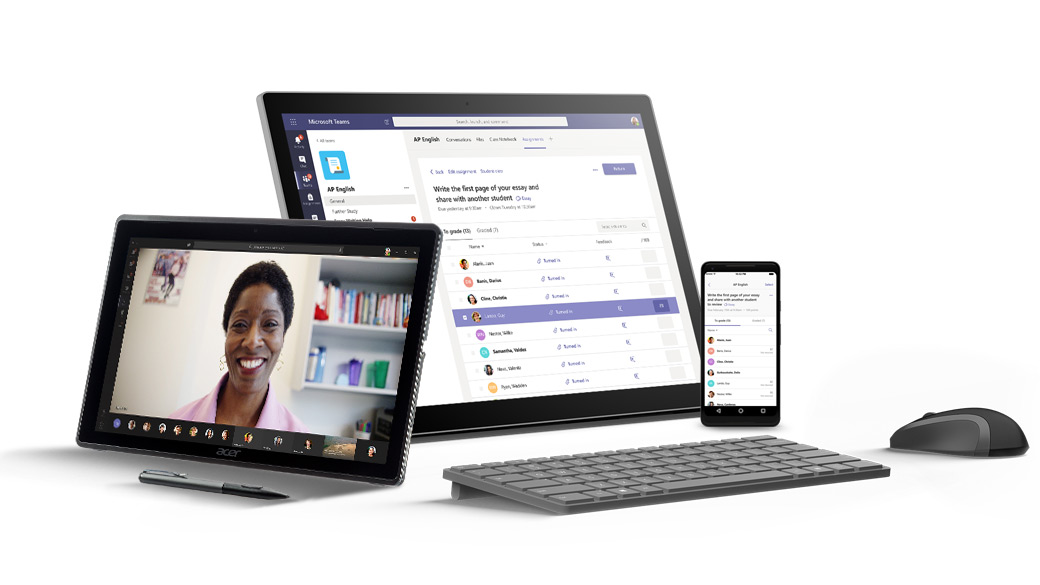At its fall Ignite conference this year, Microsoft made some very interesting announcements about its portfolio of tools and services. The tech giant also made a bunch of announcements regarding the new features, security updates, functionalities, and more for Microsoft Teams — the company’s wildly successful collaboration app. Teams has been gaining tremendous traction due to the ongoing COVID-19 pandemic and has taken considerable market share from rival Slack. With companies switching to remote and hybrid work cultures, the need for a strong, efficient, and reliable collaboration platform is on the rise. This has allowed Microsoft to iteratively improve and bake in several essential features in the Teams, making it one of the most used collaboration platforms across several domains, including IT, education, and marketing.
At this year’s fall Ignite conference, Microsoft announced improvements in the Teams app focusing on security, feature improvements, mixed and virtual-reality capabilities, and more. Here are the major announcements made about Microsoft Teams at the event:
Microsoft Loop
Microsoft Loop is the company’s newest collaboration tool that allows users to work simultaneously with other people while integrating with other applications like Microsoft Teams, Outlook, OneNote, and more apps in Microsoft’s arsenal. The tool allows users to attach a dynamic loop component such as a poll or a status bar in a Teams chat, letting team members collaborate. There are Loop pages to serve as a blank canvas or whiteboard where teams can move around elements, files, links, data, and more to organize the content for the team members in a collaborative manner. Lastly, there are loop workspaces that provide a shared space for the teams to discuss the work, set and track goals, and collaboratively manage priorities.
Microsoft also confirmed that it would be announcing more details and the availability of the Microsoft Loop app in the upcoming months.
[tg_youtube video_id=”BkhaV46HM2E”]
Mesh for Teams introduced
Microsoft also announced that it is planning to launch a preview of Mesh-enabled features and capabilities for Teams users. The company said it is working on bringing these experiences for Teams users on their PCs, mobiles, and mixed-reality headsets by the first half of 2022.
Mesh allows users to share and collaborate spatially on existing Microsoft tools and platforms and make their avatars for meetings or any virtual collaboration. Mesh also enables organizations to create immersive virtual conference rooms, meeting setups, or networking lounges to allow better collaboration. The company also confirmed that they built Mesh-power immersive spaces with Accenture, which uses mixed-reality to onboard new employees.
According to John Roach, an executive architect in Microsoft’s digital transformation services, “Mixed-reality capabilities of Microsoft Mesh allow people in different physical locations to join collaborative and shared holographic experiences with the productivity tools of Teams, where people can join virtual meetings, send chats, collaborate on shared documents, and more.”
Teams Connect and Shared Channels
With Teams Connect, Microsoft offers a secure means of communicating and collaborating with external parties. The company plans to release an update for Chat with Teams to allow Teams users to chat, communicate, and collaborate with anyone outside the organization’s network. According to Microsoft, users will be able to invite people to chat on Teams through an email address or phone number of an external user and still have the organization’s security and compliance policies in place to secure the channel.

The Shared Channels from Microsoft will allow users to have a seamless and scalable experience to collaborate in real-time on apps and share channels with up to 50 teams and as many organizations as you need. Teams Connect and the new Shared Channels will be available in public preview in the first quarter of 2022.
New tools and integrations
Microsoft also announced a bunch of new integrations, enhancements, and collaborative apps at Ignite fall. According to Microsoft, Teams will now enable users to integrate their favorite apps into their workflows by giving developers the ability to build collaborative apps within their digital workspaces, including chat, channels, and meetings. This includes integrations with Dynamics 365 for accessible business data, increased collaboration, and real-time engagement. More information about this integration can be found here.
The new Azure communication services now allow building custom applications that interact with Teams and enable users to extend their meeting experiences into other apps and processes. Microsoft confirmed that this update will be available starting Dec 1.
Teams Phone
Microsoft also announced some interesting updates to Teams Phone that will now allow a full spectrum of end-to-end calling solutions ranging from simple 1:1 calling to serving in business-critical scenarios like handling contact center operations. More information about the Microsoft Teams’ calling plans can be found here.
There is more
Microsoft announced a bunch of platform updates in the chat section, including an option to create a “chat with self” to store some handy information, a new compact model to allow users to see 50% more massage content on screen, over 800 new 3D emojis to react in chats, scheduled message sending option, and more. Microsoft also announced new security and compliance updates such as device management alerts, workspace management options, ability to monitor device health, Auto labeling 2.0, customer key availability for GCC, GCC-high, DoD Cloud, channel sites management, and more. For more information and all other announcements made at this year’s fall Ignite conference, visit here.
Featured image: Shutterstock



